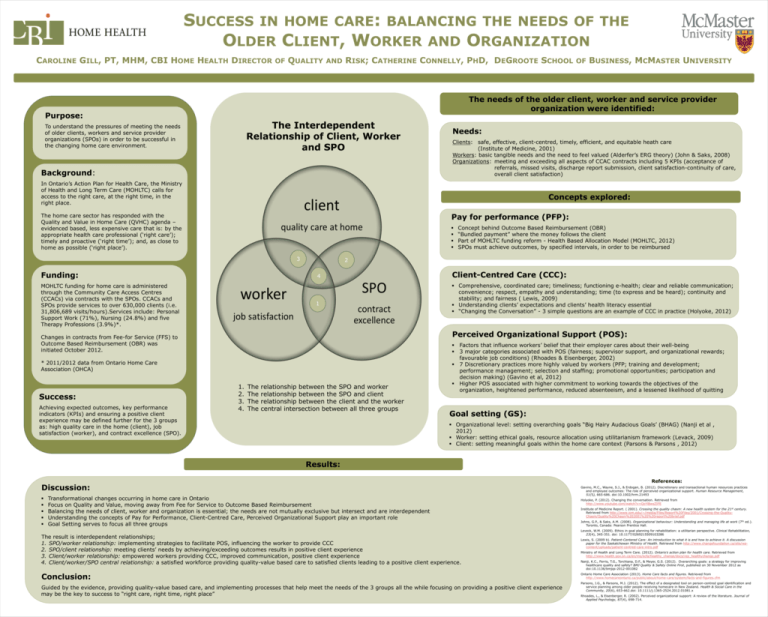
SUCCESS IN HOME CARE: BALANCING THE NEEDS OF THE
OLDER CLIENT, WORKER AND ORGANIZATION
CAROLINE GILL, PT, MHM, CBI HOME HEALTH DIRECTOR
OF
QUALITY
AND
RISK; CATHERINE CONNELLY, PHD, DEGROOTE SCHOOL
The Interdependent
Relationship of Client, Worker
and SPO
To understand the pressures of meeting the needs
of older clients, workers and service provider
organizations (SPOs) in order to be successful in
the changing home care environment.
Background:
Needs:
Clients: safe, effective, client-centred, timely, efficient, and equitable heath care
(Institute of Medicine, 2001)
Workers: basic tangible needs and the need to feel valued (Alderfer’s ERG theory) (John & Saks, 2008)
Organizations: meeting and exceeding all aspects of CCAC contracts including 5 KPIs (acceptance of
referrals, missed visits, discharge report submission, client satisfaction-continuity of care,
overall client satisfaction)
In Ontario’s Action Plan for Health Care, the Ministry
of Health and Long Term Care (MOHLTC) calls for
access to the right care, at the right time, in the
right place.
Concepts explored:
Pay for performance (PFP):
The home care sector has responded with the
Quality and Value in Home Care (QVHC) agenda –
evidenced based, less expensive care that is: by the
appropriate health care professional (‘right care’);
timely and proactive (‘right time’); and, as close to
home as possible (‘right place’).
3
Funding:
Concept behind Outcome Based Reimbursement (OBR)
“Bundled payment” where the money follows the client
Part of MOHLTC funding reform - Health Based Allocation Model (MOHLTC, 2012)
SPOs must achieve outcomes, by specified intervals, in order to be reimbursed
2
4
MOHLTC funding for home care is administered
through the Community Care Access Centres
(CCACs) via contracts with the SPOs. CCACs and
SPOs provide services to over 630,000 clients (i.e.
31,806,689 visits/hours).Services include: Personal
Support Work (71%), Nursing (24.8%) and five
Therapy Professions (3.9%)*.
1
Client-Centred Care (CCC):
Comprehensive, coordinated care; timeliness; functioning e-health; clear and reliable communication;
convenience; respect, empathy and understanding; time (to express and be heard); continuity and
stability; and fairness ( Lewis, 2009)
Understanding clients’ expectations and clients’ health literacy essential
“Changing the Conversation” - 3 simple questions are an example of CCC in practice (Holyoke, 2012)
Perceived Organizational Support (POS):
Changes in contracts from Fee-for Service (FFS) to
Outcome Based Reimbursement (OBR) was
initiated October 2012.
* 2011/2012 data from Ontario Home Care
Association (OHCA)
Achieving expected outcomes, key performance
indicators (KPIs) and ensuring a positive client
experience may be defined further for the 3 groups
as: high quality care in the home (client), job
satisfaction (worker), and contract excellence (SPO).
BUSINESS, MCMASTER UNIVERSITY
The needs of the older client, worker and service provider
organization were identified:
Purpose:
Success:
OF
1.
2.
3.
4.
The
The
The
The
relationship between the SPO and worker
relationship between the SPO and client
relationship between the client and the worker
central intersection between all three groups
Factors that influence workers’ belief that their employer cares about their well-being
3 major categories associated with POS (fairness; supervisor support, and organizational rewards;
favourable job conditions) (Rhoades & Eisenberger, 2002)
7 Discretionary practices more highly valued by workers (PFP; training and development;
performance management; selection and staffing; promotional opportunities; participation and
decision making) (Gavino et al, 2012)
Higher POS associated with higher commitment to working towards the objectives of the
organization, heightened performance, reduced absenteeism, and a lessened likelihood of quitting
Goal setting (GS):
Organizational level: setting overarching goals “Big Hairy Audacious Goals’ (BHAG) (Nanji et al ,
2012)
Worker: setting ethical goals, resource allocation using utilitarianism framework (Levack, 2009)
Client: setting meaningful goals within the home care context (Parsons & Parsons , 2012)
Results:
Discussion:
Transformational changes occurring in home care in Ontario
Focus on Quality and Value, moving away from Fee for Service to Outcome Based Reimbursement
Balancing the needs of client, worker and organization is essential; the needs are not mutually exclusive but intersect and are interdependent
Understanding the concepts of Pay for Performance, Client-Centred Care, Perceived Organizational Support play an important role
Goal Setting serves to focus all three groups
The result is interdependent relationships;
1. SPO/worker relationship: implementing strategies to facilitate POS, influencing the worker to provide CCC
2. SPO/client relationship: meeting clients’ needs by achieving/exceeding outcomes results in positive client experience
3. Client/worker relationship: empowered workers providing CCC, improved communication, positive client experience
4. Client/worker/SPO central relationship: a satisfied workforce providing quality-value based care to satisfied clients leading to a positive client experience.
Conclusion:
Guided by the evidence, providing quality-value based care, and implementing processes that help meet the needs of the 3 groups all the while focusing on providing a positive client experience
may be the key to success to “right care, right time, right place”
References:
Gavino, M.C., Wayne, S.J., & Erdogan, B. (2012). Discretionary and transactional human resources practices
and employee outcomes: The role of perceived organizational support. Human Resource Management,
51(5), 665-686. doi:10.1002/hrm.21493
Holyoke, P. (2012). Changing the conversation. Retrieved from
http://www.youtube.com/watch?v=QoYlBwsZIFE
Institute of Medicine Report. ( 2001). Crossing the quality chasm: A new health system for the 21st century.
Retrieved from http://www.iom.edu/~/media/Files/Report%20Files/2001/Crossing-the-QualityChasm/Quality%20Chasm%202001%20%20report%20brief.pdf
Johns, G.P., & Saks, A.M. (2008). Organizational behaviour: Understanding and managing life at work (7th ed.).
Toronto, Canada: Pearson Prentice Hall.
Leveck, W.M. (2009). Ethics in goal planning for rehabilitation: a utilitarian perspective. Clinical Rehabilitation,
23(4), 345-351. doi: 10.1177/0269215509103286
Lewis, S. (2009 b). Patient-Centered Care: An introduction to what it is and how to achieve it. A discussion
paper for the Saskatchewan Ministry of Health. Retrieved from http://www.changefoundation.ca/site/wpcontent/uploads/patient-centred-care-intro.pdf
Ministry of Health and Long Term Care. (2012). Ontario’s action plan for health care. Retrieved from
http://www.health.gov.on.ca/en/ms/ecfa/healthy_change/docs/rep_healthychange.pdf
Nanji, K.C., Ferris, T.G., Torchiana, D.F., & Meyer, G.S. (2012). Overarching goals: a strategy for improving
healthcare quality and safety? BMJ Quality & Safety Online First, published on 30 November 2012 as
doi:10.1136/bmjqs-2012-001082
Ontario Home Care Association (2013). Home Care facts and figures. Retrieved from
http://www.homecareontario.ca/public/about/home-care/system/facts-and-figures.cfm
Parsons, J.G., & Parsons, M.J. (2012). The effect of a designated tool on person-centred goal identification and
service planning among older people receiving homecare in New Zealand. Health & Social Care in the
Community, 20(6), 653-662.doi: 10.1111/j.1365-2524.2012.01081.x
Rhoades, L., & Eisenberger, R. (2002). Perceived organizational support: A review of the literature. Journal of
Applied Psychology, 87(4), 698-714.








